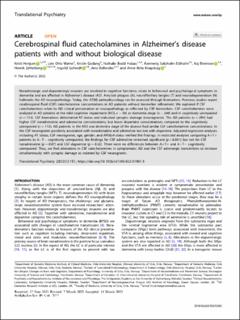| dc.contributor.author | Henjum, Kristi | |
| dc.contributor.author | Watne, Leiv | |
| dc.contributor.author | Godang, Kristin | |
| dc.contributor.author | Halaas, Nathalie Bodd | |
| dc.contributor.author | Eldholm, Rannveig Sakshaug | |
| dc.contributor.author | Blennow, Kaj | |
| dc.contributor.author | Zetterberg, Henrik | |
| dc.contributor.author | Saltvedt, Ingvild | |
| dc.contributor.author | Bollerslev, Jens | |
| dc.contributor.author | Knapskog, Anne Brita | |
| dc.date.accessioned | 2022-12-30T08:42:05Z | |
| dc.date.available | 2022-12-30T08:42:05Z | |
| dc.date.created | 2022-04-23T13:46:01Z | |
| dc.date.issued | 2022 | |
| dc.identifier.citation | Translational Psychiatry. 2022, 12 . | en_US |
| dc.identifier.issn | 2158-3188 | |
| dc.identifier.uri | https://hdl.handle.net/11250/3040017 | |
| dc.description.abstract | Noradrenergic and dopaminergic neurons are involved in cognitive functions, relate to behavioral and psychological symptoms in dementia and are affected in Alzheimer’s disease (AD). Amyloid plaques (A), neurofibrillary tangles (T) and neurodegeneration (N) hallmarks the AD neuropathology. Today, the AT(N) pathophysiology can be assessed through biomarkers. Previous studies report cerebrospinal fluid (CSF) catecholamine concentrations in AD patients without biomarker refinement. We explored if CSF catecholamines relate to AD clinical presentation or neuropathology as reflected by CSF biomarkers. CSF catecholamines were analyzed in AD patients at the mild cognitive impairment (MCI; n = 54) or dementia stage (n = 240) and in cognitively unimpaired (n = 113). CSF biomarkers determined AT status and indicated synaptic damage (neurogranin). The AD patients (n = 294) had higher CSF noradrenaline and adrenaline concentrations, but lower dopamine concentrations compared to the cognitively unimpaired (n = 113). AD patients in the MCI and dementia stage of the disease had similar CSF catecholamine concentrations. In the CSF neurogranin positively associated with noradrenaline and adrenaline but not with dopamine. Adjusted regression analyses including AT status, CSF neurogranin, age, gender, and APOEε4 status verified the findings. In restricted analyses comparing A+T+ patients to A−T− cognitively unimpaired, the findings for CSF adrenaline remained significant (p < 0.001) but not for CSF noradrenaline (p = 0.07) and CSF dopamine (p = 0.33). There were no differences between A+T+ and A−T− cognitively unimpaired. Thus, we find alterations in CSF catecholamines in symptomatic AD and the CSF adrenergic transmitters to increase simultaneously with synaptic damage as indexed by CSF neurogranin. | en_US |
| dc.language.iso | eng | en_US |
| dc.publisher | Springer Nature | en_US |
| dc.rights | Navngivelse 4.0 Internasjonal | * |
| dc.rights.uri | http://creativecommons.org/licenses/by/4.0/deed.no | * |
| dc.title | Cerebrospinal fluid catecholamines in Alzheimer's disease patients with and without biological disease | en_US |
| dc.title.alternative | Cerebrospinal fluid catecholamines in Alzheimer's disease patients with and without biological disease | en_US |
| dc.type | Journal article | en_US |
| dc.type | Peer reviewed | en_US |
| dc.description.version | publishedVersion | en_US |
| dc.source.volume | 12 | en_US |
| dc.source.journal | Translational Psychiatry | en_US |
| dc.identifier.doi | 10.1038/s41398-022-01901-5 | |
| dc.identifier.cristin | 2018622 | |
| cristin.ispublished | true | |
| cristin.fulltext | original | |
| cristin.qualitycode | 1 | |

